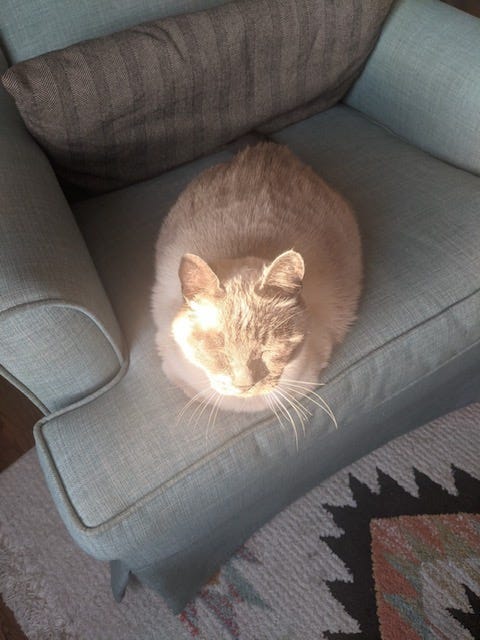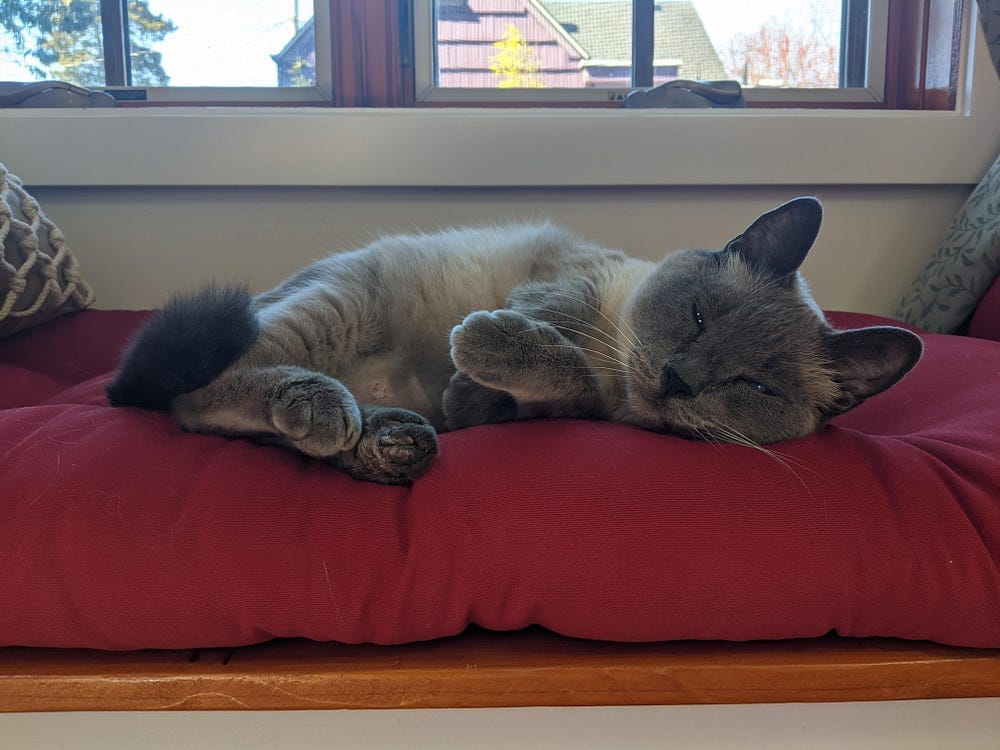The Frivolous Use of Pet Euthanasia
And Using it for Every Pet Death - No Matter the Circumstance
I’m afraid it’s not good news,” the vet told me when he came into the examining room at the Animal Hospital.
A few weeks ago, after we got back from a vacation, we noticed our cat Parsnip’s belly was pretty big. We just thought the cat sitter had overfed him and that he gained weight. Then, he wasn’t eating much nor was he as active. We took him to the vet and it turned out Parsnip was severely anemic, full of fluids, and had a tumor. I asked the vet to tell me the truth about his condition. He said that in his experience surgery wasn’t going to change the outcome and that it was time to let go of Parsnip. After all, he was 12 years old. He talked about my options which were to bring him in to have him “put to sleep.” He suggested I don’t wait more than a day or two — otherwise I would only prolong his suffering. I could also have a pet euthanizing service come to the house. He quickly mentioned natural death. He did not recommend that because it’s hard to watch an animal suffer and it isn’t very “humane.” In that emotional moment, I thought, “I don’t want him to suffer.” I made the decision right then to have him put down. The real question wasn’t if I should euthanize Parsnip, but when.
We brought him home and gave him lots of love. Friends came by to say their goodbyes. He spent those days perched on a chair. He didn’t really lay down. Maybe it was too painful. We served him warmed salmon. He would eat a few morsels and then just lick it. He wasn’t sleeping and he didn’t purr much — but he still did a little. I brought him outside and he perched himself on the warm sidewalk, looking around — ears perked forward. He was weak. He had quit drinking water. When we stroked his fur, we felt his bony spine. His body was wasting away.
After four days of watching this, we decided it was time. On the drive to the vet, he sat on my lap — looking around, ears perked forward. He was always a curious kitty. I held him in my arms when we brought him into the vet hospital. After we signed in the paperwork and paid the fee, Parsnip looked around and I felt his body cringe in fear as he stuffed his head into my armpit seeking comfort. It was as if he was saying “Nooo! Not the vet. No!” We passed him off to a kind vet tech who took him to the back to insert a catheter. When she picked him up, she nuzzled him and sweetly said “Awww honey.”
We waited and waited. After thirty minutes they brought Parsnip to the room to begin the procedure. His paws were shaved and the vet said they had a hard time getting the catheter in because his veins were so shriveled (due to lack of water). He looked defeated, so sad, and kind of mad. Like, if he had the energy, he would have clawed and bit us. It was as if he were communicating, “I can’t believe you’re doing this to me.” During the quick procedure, the vet gently said “Talk to him” while he injected Parsnip firstly with a sedative and then a barbiturate. The process seemed painless. He didn’t flinch or moan and then he was gone.
On the drive home, I couldn’t stop thinking of an essay that I’d read years ago called “A Hanging” by George Orwell. Orwell talks of a convicted man going to be hung and how right up until the moment of his hanging, the man was still living. His fingernails were growing, new tissues forming, bowels were digesting food, and the man still cared about his comfort when he averted a puddle to not get his feet wet. I felt overcome with guilt. Guilt that we took away Parsnip’s life. Because he was still living. Yes, the life in him was diminished, but it was still there. He was looking around, sitting on our lap (even purring a few times), and eating morsels of salmon. His lungs still breathed (albeit more slowly), his body still moved, and his nose still sniffed. I felt terrible about what we had done to Parsnip.
Instead of letting his body die naturally of its own volition, we exerted a force onto his body and snuffed out his life.
We also did not let him experience his own death. First he was given a sedative. Then, once he was unconscious, he was executed. So suddenly, he is dead — without knowing it was happening.
Parsnip never gave his consent to any of this.
In this whole process, the idea of letting him die naturally didn’t seem like an option. When I told people that we were going to put our cat to sleep, they were sympathetic saying things like: “That’s so hard. We had to do that last year with our dog.” I told my best friend, and she said “Wow. It’s been a sad week. My boyfriend’s mom also had to put her dog to sleep this week.” Not a single person asked, “Do you really have to put him to sleep?” Because, pet euthanization is just something one “has” to do. When researching what to do, most online advice says it’s selfish not to euthanize a pet and that it is a gift to end their suffering. But, is it? There is no discussion of what a pet might prefer.
I don’t know anyone who consciously opted for a natural death when it came to their pet’s last days. It seems everyone makes that last drive to the vet. I wonder what percentage of pet guardians opt for a natural death instead of euthanasia. I suspect that percentage is quite low.
Just because we have euthanasia technology does not mean we should always use it. It seems this technology is used indiscriminately, no matter the circumstance. Maybe it’s the right thing to do if a pet gets hit by a car, is half alive, and maimed. But, maybe it’s the wrong thing to do if a pet is dying of natural causes. I read a vet’s opinion on the matter and she said euthanasia is “always” the right thing. (The photo below could explain why).
Watching Parsnip at the vet that day, I know we did not avoid any suffering. We put him through distress when he realized where he was. In his weakest moment, he was separated from his guardians while strangers handled him. The vet struggled for 30 minutes to get a needle in his shriveled vein. He was medically tortured all in the name of “preventing suffering.” The idea that putting a pet to sleep prevents suffering is a lie.
How do we know he would have suffered more if he had been given a natural death? We don’t actually know that. The future is unknowable. Perhaps a natural death for Parsnip would have been a calm transition, in his familiar environment, when he was ready. I suspect animals have a different relationship to suffering and death than humans. They’re more connected to death than people. Zebras, for example, spend their lives trying to avoid death, since they’re prey animals. Predatory animals are trying to bring about death, in order to get food.
Animals appear to accept death better than humans. They don’t fight it. My cousin’s old horse just laid down in the field and died. A friend’s cat crawled under the bed and died. Elderly reindeer go outside the herd and lay down and die. They know it is their time and they accept it graciously. The few stories I have heard about natural pet death sound quite peaceful. They actually sound more humane than euthanasia.
What I do know of our kitty is that he adored spending time with me and my husband— preferably eight days a week. Once, when I left the apartment, he threw himself against the door clawing and meowing as if to say, “No! Don’t go!” He always got up from his napping spot and trundled over to the door to greet us when we got home. Of all the places to lie down in our large apartment, he would often choose a smelly coat that stunk of my body odor. When we worked from home, he was in bliss, sleeping and purring on a lap. He even sat in the towel bin, in the bathroom, when I was taking a bath — just wanting to be near one of his guardians. I never knew a cat could give so much love.
I have a strong sense that Parsnips’ dying wish would have been to just be at home, with his people nearby holding his paw and stroking him — sitting on the fluffy blanket my friend Esther crocheted. He would have wanted to have every single possible moment with his pet parents, because that’s how he lived his life. We robbed him of those moments.
I made the wrong choice in putting Parsnip to sleep. He wasn’t ready to go. I should not have snuffed out what was left of his life. That wasn’t my decision to make. It was his. We egregiously violated his bodily autonomy. But, we’re so steeped in a pet-euthanizing culture that nobody even questions this practice. If you do let your pet die naturally, people will say really mean things about you. I feel guilty about what I did but I also know I am forgiven. For I knew not what I was doing. I live in a society where pet deaths are scheduled, the phrase “have to” is automatically used when it comes to pet euthanasia, and I received no guidance from elders telling me to reconsider my decision. The question is never “if,” it is always “when.”
I give myself grace. My cat loved me fiercely and I know he wouldn’t want me to be racked with guilt about what I did. He would say “You did the wrong thing. But, I forgive you because my love for you knows no end. Let go of your guilt. Cheer up. Don’t cry.”
Parsnips’ last gift to me was the gift of this regret. It led to experiential wisdom. I doubt I will ever euthanize a pet again. Instead, I will do my best to give them the full experience both of life, and of dying.
Divine Nature is intended to heal, inspire, and cultivate hope—thus, it is given freely.
Essays are published about every six weeks, or less. Please subscribe knowing your inbox will not be inundated.







Ohhhh I FULLY AGREE I have so much to say about this… I’m so heartbroken about it